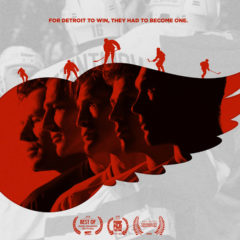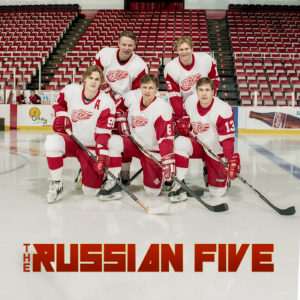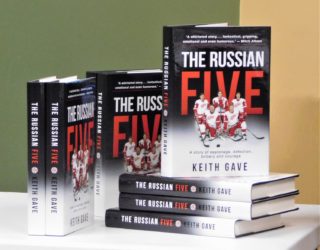
The Russian Five is a very detailed and, at times, intense documentary on the Detroit Red Wings, and how their quest for the Stanley Cup had them looking at some of the most talented and, at the time, untouchable players in the world to make their team a winning one.
But to do that, they must first extract players they drafted from behind the Iron Curtain of the Soviet Union, and along the way, they may have changed some public perceptions, but they definitely changed how hockey was played in the NHL, and perhaps elevated it.
As one Canadian Amazon reviewer commented, this is an “Excellent docudrama with historical significance in sport and international relations.” And who can argue… In fact, that’s why I feel that this would be perfect for a fictionalized more espionage-centric version, which I would love to see, but let’s first talk about the fact before we dive into the fiction.
And of course, the book, written by Keith Gave (it was his story, we’ll get there,) on which this sports docudrama is based on has the subtitle of “A Story of Espionage, Defection, Bribery and Courage” so I’m sure someone is working on the blockbuster fictionalization already, but what is it about?
There are three distinct pieces to this story. The first is the off the ice management of the team. Leadership and decisions based on how to put out on the ice the best team possible. The second is the on-ice performance of that team, and the third and perhaps most interesting is the political and cultural events that impacted both one and two.
 First, let’s talk about management. Mike Illitch buys the Red Wings and brings in Jim Devellano to build a winner, through the draft. This isn’t an overnight process, so while they selected Steve Yzerman with their first pick in the ‘83 draft, which was the first that Illistch and Devellano would be a part of together, it was the pick they made fourth and 11th that is at the heart of this story.
First, let’s talk about management. Mike Illitch buys the Red Wings and brings in Jim Devellano to build a winner, through the draft. This isn’t an overnight process, so while they selected Steve Yzerman with their first pick in the ‘83 draft, which was the first that Illistch and Devellano would be a part of together, it was the pick they made fourth and 11th that is at the heart of this story.
“When you draft a player, you own their rights, basically, forever. But everybody was scared to use draft picks on the Russian players because you didn’t know if you’d ever see them. And draft picks are assets, and you didn’t want to use an asset on something that you didn’t know if you’d ever see.”
They selected Sergei Fedorov and Vladimir Konstantinov with those two picks, and the story for how they got out behind the Iron Curtain to make their NHL debuts is part of what brings in the espionage aspect of this whole story, and it’s what transcends this story from something that a hockey fan or just a sports fan, in general, can relate to, to something much bigger and broader. It’s also where international politics come into play.
But it is the Russian Five, not русский два (Russian Two), so the other three? Vyacheslav “Slava” Kozlov was also drafted, while Slava Fetisov was traded from the New Jersey Devils and Igor Larionov was traded from the San Jose Sharks.
There’s plenty more detail and intrigue I’m skipping over for now, but it’s there and you should watch the documentary… Anyway, the Russian Five are now all on the same team and new coach Scotty Bowman put them all on the same line, which means they are all on the ice at the same time, for those of you not familiar with hockey. This brought the European style of hockey to the NHL for good, but it wasn’t until Bowman changed up his lines to mix the Russian Five with the rest of the team that they all started to play as one team. This is where the “on ice” piece of the puzzle is placed.
For those wondering how they changed the NHL game, it’s really simple. Before the Europeans, the Russians among them came to the NHL, it was a forward game. Pass the puck forward, dump it into the corners and chase after it. The Europeans played keep-away with players moving and passing the puck in all directions in order to maintain position and find an opening. This is how the game is played now, it was not always the case. The Russian Five brought this to the forefront by winning with this style of play, and of course, if one team wins with a new strategy, the league takes notice.
 As the team was built and through the early and mid-’90s, the Red Wings were getting in the playoffs, they were no longer the joke they were when Illitch bought the team and by the time they beat the Colorado Avalanche (who knocked them out the previous year) to then sweep the 1997 Stanley Cup against the Philadelphia Flyers, it was mission accomplished.
As the team was built and through the early and mid-’90s, the Red Wings were getting in the playoffs, they were no longer the joke they were when Illitch bought the team and by the time they beat the Colorado Avalanche (who knocked them out the previous year) to then sweep the 1997 Stanley Cup against the Philadelphia Flyers, it was mission accomplished.
But six days after that win a limousine accident took away what would have been the remainder of Konstantinov’s career, and the partying came to end. And while they did use that as motivation to win back to back Cups, you have to say, perhaps there was more to it than that? And how do we even know all of what I’ve said, plus details in the documentary about the espionage aspects of getting the Russians out from behind the Iron Curtain?
After drafting the Russians, they turned to the only knowledgeable hockey person in Detroit that the Red Wings knew who also spoke Russian… Sports journalist Keith Gave.
As Keith says in the film “I’d read enough about reporters being used as pawns in the middle of espionage and I’m figuring ‘Why not me?’”
“I said, ‘You know, the only thing I ask… I want the story first. If you can give me that, I’ll pass along a message to these guys. Couple weeks later, I was on my way to Helsinki, Finland.”
He not only got the message across, he got his story, he got a book, and now he has a starring role in this documentary.
 But remember I spoke about the possibility of a fictionalized version? Yeah, the story beats I’ve told you lend themselves to a sports-centric espionage thriller, loosely based on a true story, if you wanted to go that direction. Seriously, I’ve read and watched plenty of espionage films and this one has all of the story beats, plus it has the Americans and the Russians going against each other yet again, and little details in the truth, like how Federov didn’t tell his KGB guy about his first meeting with the Red Wings during his tour of the states during the first “Super Series” in Chicago, I mean… Those players didn’t just have KGB with them, they knew who they were!
But remember I spoke about the possibility of a fictionalized version? Yeah, the story beats I’ve told you lend themselves to a sports-centric espionage thriller, loosely based on a true story, if you wanted to go that direction. Seriously, I’ve read and watched plenty of espionage films and this one has all of the story beats, plus it has the Americans and the Russians going against each other yet again, and little details in the truth, like how Federov didn’t tell his KGB guy about his first meeting with the Red Wings during his tour of the states during the first “Super Series” in Chicago, I mean… Those players didn’t just have KGB with them, they knew who they were!
It wasn’t a spy undercover, it was, that is my KGB guy!
Perhaps it doesn’t need a fictionalization, perhaps this is good enough, and it absolutely is, but it is teasingly interesting to think of what Hollywood writers could do with such facts as those which are introduced in this film, and I’m sure the book that Keith Gave wrote is full of even more. There’s only so much you can fit into a 98-minute documentary.
Honestly, I can’t recommend it enough, for everyone. If you like hockey, history, espionage, culture, or just an intriguing story.
Read the Secret File of technical information and quotes from The Russian Five.